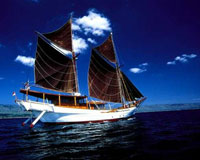 For centuries, the Bugis people have sailed from South Sulawesi across the shallow seas of the Indonesian archipelago. They would sail east and west on the monsoons, regularly trading as far as Northern Australia in their two masted ships, known as phinisi (often also spelled pinisi.) The great age of sail, which ended in the West in the early twentieth century, never quite ended in Indonesia. The Bugis have continued to build their phinisi on the beaches of Sulawesi and continue to sail the islands to this day. In addition to serving as transport and traders, the phinisi are also increasingly used as tour, cruise and dive boats. Some are fitted out as yachts.
For centuries, the Bugis people have sailed from South Sulawesi across the shallow seas of the Indonesian archipelago. They would sail east and west on the monsoons, regularly trading as far as Northern Australia in their two masted ships, known as phinisi (often also spelled pinisi.) The great age of sail, which ended in the West in the early twentieth century, never quite ended in Indonesia. The Bugis have continued to build their phinisi on the beaches of Sulawesi and continue to sail the islands to this day. In addition to serving as transport and traders, the phinisi are also increasingly used as tour, cruise and dive boats. Some are fitted out as yachts.
What brought this to mind was an article posted by Tom Russell in the Traditional Sail Professionals Linked-in group, about a large phinisi recently launched from the beach at Tanjung Bira, in Bulukumba, South Sulawesi.
Bulukumba shipyard launches another impressive Phinisi Schooner
From a design point of view, the phinisi are a fascinating mix of ancient and modern. Unlike Western wooden ships where the frames are erected first and the planking is secured to the frames, when building a phinisi, the planking is assembled first, connected edge to using wooden dowels. After the planking is underway, the frames are attached. Except for clinker built boats, where the planing overlaps, plank first construction disappeared in the West many hundreds of years ago.
The phinisi’s steering is also an ancient design. Whereas in China stern rudders were adopted by the tenth century (and perhaps much earlier,) and in the West, keel-hung stern rudders were adopted by about the 14th century, the phinisi still use twin steering oars that would have been familiar to Roman helmsman.
Moving above the deck, the pinisi becomes more modern, relatively speaking. The deck house and the gaff rig were both probably adopted from the Dutch. The rig is different from typical gaff rigs in several respects. The phinisi masts are usually built as narrow tripods. The gaff yards are fixed with the sails brailed up against the mast when not set. While the phinisis are often referred to as “phinisi schooners” most are, in fact, ketch rigged with the larger mast forward.
Most phinisis these days have motors and some, the Kapal Layar Mesin (“Motor Driven Sailing Vessel”,) rely primarily on their engines while still retaining a sailing rig.
Phinisi Sailing Boat of Konjos Tribes From Tana Beru Bulukumba Indonesia

Pingback: abadia-poblet.org » Blog Archive » The Indonesian Phinisi
Pingback: Dream Symphony and the Fusion Schooners: Modern High-Tech Wooden Shipbuilding | Old Salt Blog – a virtual port of call for all those who love the sea
Pingback: The Schooners of Madagascar and the Brittany Shipwrights | Old Salt Blog – a virtual port of call for all those who love the sea